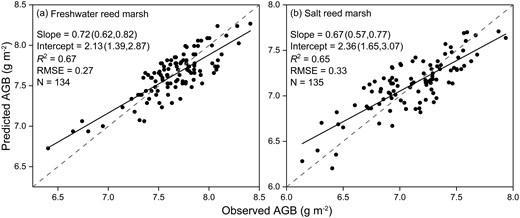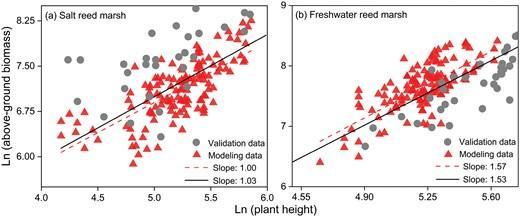#MachineLearning #ModelEvaluation #Calibration #HealthcareAI #AIethics #DecisionTheory
#ModelEvaluation
💻 #AllometricEquations for estimating above- and below-ground #Biomass of #PhragmitesAustralisMarshes.
Characteristics:
1️⃣ Divided into saltwater marshes and freshwater marshes.
2️⃣ Using plant height as the sole predictor.
3️⃣ It is a power-law allometric model.
#ModelEvaluation
https://doi.org/10.1093/jpe/rtae113
The lesson: just because a model is branded for uncertainty doesn’t mean it delivers. Stop the monkey data science—science is not crowd-following.
#DataScience #NGBoost #ProbabilisticModels #ModelEvaluation #MachineLearning #StopTheHype
---
Accuracy! To counter regression dilution, a method is to add a constraint on the statistical modeling.
Regression Redress restrains bias by segregating the residual values.
My article: http://data.yt/kit/regression-redress.html
#bias #modeling #dataDev #AIDev #modelEvaluation #regression #modelling #dataLearning #linearRegression #probability #probabilities #statistics #stats #correctionRatio #ML #distributions #accuracy #RegressionRedress #Python #RStats
How to assess a statistical model?
How to choose between variables?
Pearson's #correlation is irrelevant if you suspect that the relationship is not a straight line.
If monotonic relationship:
"#Spearman’s rho is particularly useful for small samples where weak correlations are expected, as it can detect subtle monotonic trends." It is "widespread across disciplines where the measurement precision is not guaranteed".
"#Kendall’s Tau-b is less affected [than Spearman’s rho] by outliers in the data, making it a robust option for datasets with extreme values."
Ref: https://statisticseasily.com/kendall-tau-b-vs-spearman/
#normality #normalDistribution #modeling #dataDev #AIDev #ML #modelEvaluation #regression #modelling #dataLearning #featureEngineering #linearRegression #modeling #probability #probabilities #statistics #stats #correctionRatio #ML #Pearson #bias #regressionRedress #distributions
Dive into the world of model evaluation in machine learning! Discover how to optimize logistic regression, compare ensemble techniques, and select the best model using key performance metrics. #MachineLearning #ModelEvaluation #DataScience
There's still time to submit a proposal to “Genomic forecasting of adaptation under environmental change” special feature in AmNat! Click here for all the details: https://www.amnat.org/announcements/genomic-forecasting-feature.html
#genomicForecasting #Genomics #theory #methods #modelEvaluation #empiricalStudies #criticalViewpoints
Learn how to interpret R², the 'coefficient of determination' in regression models! 📈📚 #DataScience #RegressionAnalysis #ModelEvaluation https://towardsdatascience.com/interpreting-r%C2%B2-a-narrative-guide-for-the-perplexed-086a9a69c1ec
https://eugeneyan.com//writing/aieng-reflections/
Very nice summary of the AI Engineer Summit 2023 by @eugeneyan
4/
Below, key points:
- "lack of #ModelEvaluation"
- statistical #uncertainty & "#robustness of event attribution results"
[4] Seneviratne, et al., 2021. Chapter 11: weather and climate extreme events in a changing climate. In: Climate Change 2021: The Physical Science Basis - Contribution of Working Group I to the Sixth Assessment Report of the Intergovernmental Panel on Climate Change. IPCC, Geneva, Switzerland, pp. 1513–1766. https://purl.org/INRMM-MiD/z-ED8RQFV5
https://www.ipcc.ch/report/ar6/wg1/downloads/report/IPCC_AR6_WGI_Chapter11.pdf#page=28
Interesting paper: "Direction Augmentation in the Evaluation of Armed Conflict Predictions" by @johannes (Johannes Bracher), Lotta Rüter, Fabian Krüger, @sebastianlerch and Melanie Schienle
#Prediction #Forecasting #modelevaluation #conflictprediction
https://arxiv.org/abs/2304.12108
New open-access article on "Decomposition of the mean absolute error (MAE) into systematic and unsystematic components" in #PLOSONE, if you're into that sort of thing.
#Statistics #ModelEvaluation #ModelError
https://dx.plos.org/10.1371/journal.pone.0279774
Model Evaluation, Model Selection, and Algorithm
Selection in Machine Learning
#MachineLearning #ModelEvaluation #CrossValidation
#HyperparameterOptimization
Anyway, I keep meaning to write up a blog post on “falsehoods I have believed about measuring model performance” touching on #AppliedML issues related to #modelEvaluation, #metrics, #monitoring, #observability, and #experiments (#RCTs). The cool kids would call this #AIAlignment in their VC pitch decks, but even us #NormCore ML engineers have to wrestle with how to measure and optimize the real-world impact of our models.
I'm thinking about how to relate #ModelBuilding and #ModelEvaluation to #OpenScience. I'm not there yet, but anyone who wants to think along, feel free! Model evaluation, thinking about #validity and how #standardization and #generalisation interact, among others...
Figure on #standardisation vs #generalisation from https://doi.org/10.1111/j.1601-183X.2010.00628.x

